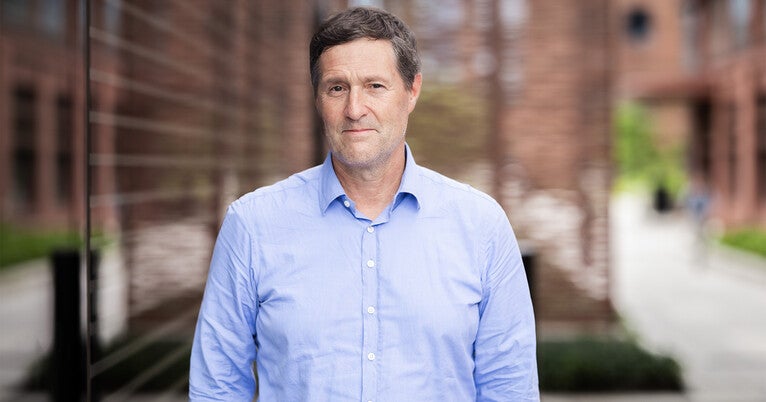Yale carbon capture center takes next steps in leadership, research
The Yale Center for Natural Carbon Capture (YCNCC), created in 2021 to study the fundamental applied science of natural carbon capture, is taking the next step in its evolution with a new managing director and promising research in key areas.
Toby Bryce, formerly an independent advisor on policy, market development, and the responsible commercialization and deployment of carbon dioxide removal (CDR) for a variety of companies and organizations, joined Yale in June. Working with inaugural faculty co-directors Liza Comita from Yale School of the Environment and David Bercovici from the Yale Faculty of Arts and Sciences, Bryce will lead YCNCC’s administration, communications, development, external affairs, and strategic efforts.
Three years ago, YCNCC was established as a hub for cutting-edge science in understanding natural processes that sequester carbon from the air and store it in the environment. It is part of Yale Planetary Solutions, a university-wide initiative that seeks to find novel solutions to environmental problems such as climate change and biodiversity loss, with virtually every academic discipline and Yale unit involved.
Yale News caught up with Bryce to talk about YCNCC’s field-leading work and upcoming programs. The interview has been edited and condensed.
For the non-scientists among us, what is natural carbon capture? Are there common misconceptions about it?
Toby Bryce: Natural carbon capture, also known as carbon dioxide removal or CDR, refers to the opportunity to leverage Earth processes that occur naturally at immense, planetary scale to remove carbon dioxide from the atmosphere. Examples include enhancing biotic carbon sinks in forests, soils, and coastal blue carbon systems; accelerating natural mineralization [weathering] cycles; and a range of approaches that take advantage of the massive carbon sequestration potential of the world ocean.
Two key points to emphasize when we talk about carbon removal: First, CDR is in no way any substitute for rapid and deep reductions to global greenhouse gas [GHG] emissions. We must reduce emissions and decarbonize the global economy as quickly and completely as possible. However, there are certain “residual” emissions that will be hard to abate in the coming decades, and the science shows that CDR at immense multi-gigaton annual scale [billions of tons per year] is an unavoidable component of the climate mitigation necessary to meet the goals of the Paris Agreement and limit warming to 1.5 or even 2 degrees Celsius.
Second, the term “carbon capture” can refer to a range of climate mitigation approaches. It is important to make clear that capturing carbon dioxide from a fossil emissions source — such as a natural gas power plant or cement kiln, often called “CCS” [carbon capture and storage] — is different from approaches that remove carbon dioxide from the atmosphere, or CDR. Either can be a beneficial climate solution, or not, depending on the specific project level techno-economics, social impacts, and co-benefits or harms, but CCS and CDR serve distinct purposes from a climate mitigation perspective, and should not be confused or conflated.
What is YCNCC’s role in developing meaningful applications for natural carbon capture concepts?
Bryce: YCNCC was founded in 2021 with a transformative gift from Fed Ex to explore fundamental and applied science relating to how natural processes can be enhanced to create effective, safe, and scalable methods to reduce GHG concentrations in the atmosphere. YCNCC scientists are working on an incredible range of cutting-edge research. Major initiatives include the Yale Applied Science and Synthesis Program [YASSP], which concentrates on forest and agroecosystem management; Enhanced Weathering, the application of ground silicate minerals such as basalt that naturally capture carbon dioxide in farmlands; and Marine CDR, which comprises a range of approaches that leverage the oceans’ vast scale to remove carbon dioxide from the atmosphere.
YCNCC scientists are also doing important work in other areas, including industrial carbon utilization, methane mitigation, and enhancing coastal blue carbon ecosystems. CDR is a new field, which we need to scale massively over the next two decades. YCNCC is dedicated to building a solid scientific foundation for key methods of natural carbon capture so that this set of promising CDR approaches can advance to have the desired climate impact.
Which areas of research excite you the most?
Bryce: I’m personally excited about CDR approaches that enhance natural processes for a few reasons. First, these approaches have tremendous potential for scale and low cost precisely because they leverage massive Earth systems like forests, soil, mineralization cycles, or the world ocean. Second, many of these approaches offer significant potential co-benefits, which will be critical for securing the social license necessary to achieve gigaton-scale CDR. For example: Healthy forests and soils provide vital ecosystem services. Enhanced weathering mitigates soil acidification and offers a potentially significant new income stream for farmers. Ocean alkalinity enhancement and coastal blue carbon systems can reduce ocean acidification locally.
Another key factor that makes me keen to work on natural carbon capture is that, despite their vast potential, these methods of CDR have been underfunded so far this decade relative to more engineered approaches, such as direct air capture. That’s why investments like FedEx’s gift to found the center — and subsequent gifts from Southwest and Boeing — are so transformative. They start to level the playing field. The fact is that the scale of CDR required to meet Paris Agreement targets is so vast that there can be no silver bullet. We will need a portfolio of gigaton-scale approaches to achieve our climate mitigation goals, potentially including direct air capture but also, and importantly, the natural carbon approaches we’re seeking to advance here at YCNCC.
As a new member of the Yale community, you have an excellent vantage point for seeing how the university’s work on climate change is having an impact. What are your thoughts on that?
Bryce: While these natural Earth processes offer great potential for scale and low cost, their “open system” qualities, or lack of clear system boundaries, make their ability to remove carbon dioxide from the atmosphere difficult to measure, monitor, and verify. For these vital climate solutions to reach their full potential, we must develop operable solutions for the monitoring, reporting, and verification [MRV] of their safety and efficacy. This is where the work of YCNCC scientists comes in.
Across each of the center’s major initiatives, YCNCC scientists are leading important, field-building research to create a solid foundation from which government policy and climate finance can advance these still-nascent natural carbon capture solutions to climate-relevant scale. YASSP’s ongoing research seeks to address certain challenges incumbent carbon markets have had accurately measuring the efficacy of regenerative agriculture and reforestation projects. The work of YCNCC geochemists is serving as the basis for the first high-quality protocols for verifying the CDR delivered by enhanced weathering in an agricultural context. YCNCC marine scientists are at the forefront of efforts to determine the safety, efficacy, and measurability of ocean alkalinity enhancement and other promising mCDR approaches.
For these methods of natural carbon capture to deliver the desired climate impact, it is critical that their advancement be led by the best available science. The impact YCNCC scientists have had on the CDR sector in its early days is the primary thing that attracted me to the managing director role. I’m excited to work with the team here to advance and scale these efforts globally in the coming years.
What new initiatives and events does the center have planned for the next academic year?
Bryce: YCNCC is all about our scientists, and they are extremely active, from the professors on our scientific leadership team, to postdocs and student researchers. In addition to a busy academic calendar, there is a steady stream of conferences, workshops, and field research. In September, several YCNCC scientists will be participating in New York Climate Week events, and YCNCC will host our annual fall research showcase in Kline Geology Lab. In December, YCNCC scientists are convening a number of sessions at the American Geophysical Union AGU24 annual meeting in Washington D.C. In April 2025, we are planning a third edition of YCNCC’s successful spring symposium, as well as ERW25, which brings the global enhanced weathering community of scientists, policymakers, NGOs, and startups to Yale’s campus to discuss how to continue to advance that promising field of natural carbon capture.
How can the wider Yale community engage with YCNCC’s work and mission?
Bryce: Please reach out! We will be re-launching our website this fall, to better communicate the tremendous work YCNCC scientists are doing both to the Yale community and externally. You can also follow us on LinkedIn and X [formerly known as Twitter], where we will be posting regularly about YCNCC news, research, publications, events, and more.













